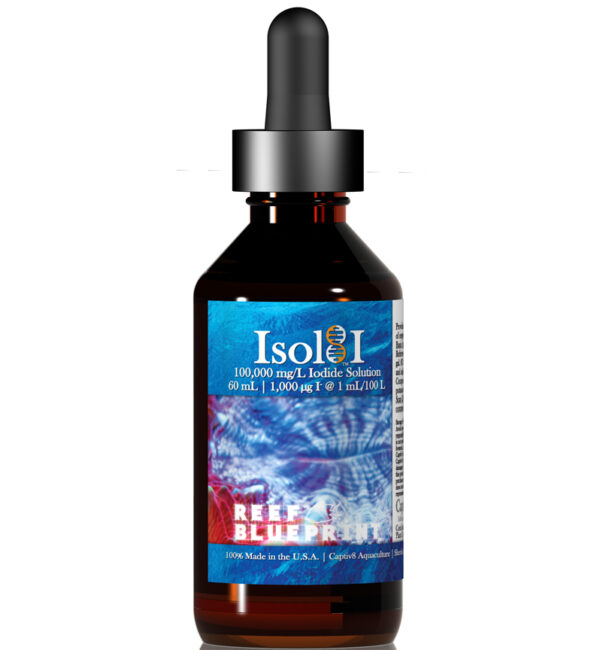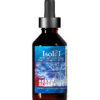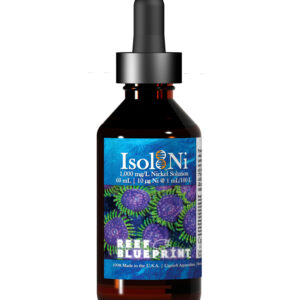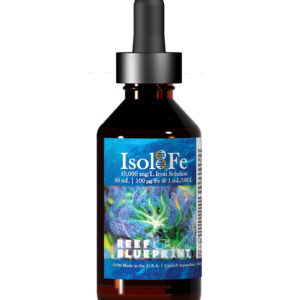Iodide sol’n; 100,000 ppm. Increases iodide (contains no iodine) in recirculating seawater systems. 1 drop (0.05 mL) per 23.7 gal. (89.5 L), or 1 mL per 473.1 gal. (1,790.8 L), once daily to maintain NSW value for S=35. 100,000 ppm iodide, derived from potassium iodide (anhydrous source, USP).
Parameter
Iodide
Value
100,000 ppm
Characteristics
- Provides iodide (contains no iodine), required for development of chitin (exoskeletal material for shrimp and other crustaceans) and antioxidant activity critical to hermatypic invertebrates. Iodide is properly considered a critical addition to recirculating marine ecosystems housing either of these groups of organisms.
- Improves color intensity and polyp extension of zooxanthellate invertebrates.
- See ‘Application’ section below for use of this solution vs. Isol8 MT.
- Active Components: Potassium iodide, anhydrous, USP.
Basic Application
- 1 drop (0.05 mL) per 23.7 gallons (89.5 L), or 1 mL per 473.1 gallons (1,790.8 L), provides NSW [I].
- 1 mL per 26.4 gallons (100 L) increases [I] by 1.00 ppm.
- Reference Standard [I]:
- 5.58×10-2 ppm (S=35.0)
- 6.33×10-2 ppm (S=40.0)
- In established systems, increase [I] up to 5% of existing ionic value daily, until desired value or reference standard is reached.
Application
Keep out of reach of children and unauthorized persons. Avoid contact with skin, eyes, and mucous membranes. Store in a cool, dry location away from sunlight.
All trace elements critical to continued functioning of photoautotrophs, including cobalt, are provided in Isol8 MT, which offers a simpler method of dosing the aforementioned elements in ratios mirroring those of natural seawater, and is recommended for general husbandry of recirculating marine ecosystems. However, iodine (as the iodide ion) is one of the handful of trace elements in which individual dosing is encouraged (in addition to Isol8 MT), due to iodide’s importance to numerous biochemical processes and the elevated rate of uptake relative to several other trace elements, particularly in recirculating marine ecosystems with dense populations of photoautotrophs and/or crustaceans (finfish generally obtain adequate iodine through the use of a suitable feeding regimen). Although we recommend that regular analysis be performed to verify iodide content and to provide a baseline value for future adjustment, there is positive visual feedback associated with iodide dosing and, in some systems, this may be adequate to guide the user in modifying dosing rate to suit cohort requirements.
The rate of ion depletion due to photoautotroph uptake is driven by various chemical and physical factors which are unique to each independently-operating recirculating system, and which are constantly changing as photoautotroph biomass increases and decreases.
Monitoring (daily) the system’s concentrations of elements provided by this formulation, as well as the concentration of nitrate, and referencing apparent changes in coloration of zooxanthellate cnidarians will enable User to adjust dosing of this formula to suit system requirements, improving overall effectiveness and resulting in less wasted solution.
Users unable to perform analyses for elements provided by this formula are recommended to monitor nitrate concentration and apparent changes in coloration of zooxanthellate cnidarians, adjusting dosage to suit system requirements. This visual approach to dosing is fastest, and for many systems will be adequate.
Recommended is diluting an appropriate volume of this solution into a larger volume of purified water (with a purity of at least 98%), and applying this diluted solution to the system with an automated dosing system throughout the photoperiod. Dosing frequency is directly proportional to stability of ionic concentrations and, resultantly, gradual changes in the coloration (manifesting as intensification) of coloration of zooxanthellate cnidarians. A 1 – 10 s drip interval during the photoperiod provides adequate ionic stability, and is recommended.
If no automated dosing system is available, then apply solution manually each day. Dosing frequency is directly proportional to stability of ionic concentrations and, resultantly, consistent changes in coloration of zooxanthellate cnidarians. Dosage volume per 24 h is divided by the dosing frequency
It is not recommended that this formulation be dosed fewer than four times weekly.
Reference Standards: 1 drop (0.05 mL) Isol8 I diluted in 26.4 gal. (100 L) water yields 0.05 ppm increase of [I]. Undiluted, 1 drop treats a volume of 23.7 gallons (89.5 L) at the reference standard of 5.59×10-2 ppm.






